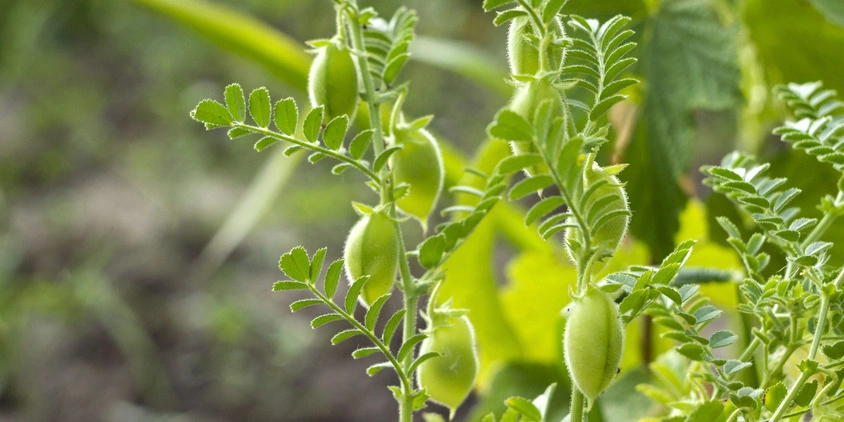
Growing Chickpeas: How To Plant, Maintain, And Harvest
Chickpea growing stands out for nitrogen fixation, water efficiency, and diversity in crop uses, including human consumption, livestock feed, and green manure. Precise timing is key to a successful crop: planting in warm soil, keeping the soil at the right moisture level as the pods fill, and harvesting before pods become too brittle.
Modern precision agriculture platforms help adjust chickpea farming operations across fields to these critical points through satellite data, weather monitoring, and advanced analytical algorithms. With proper crop monitoring and management, growing the crop helps increase farm profits and build healthier soils. Here’s a detailed overview of how chickpeas are grown, from type selection to harvesting.
What Are The Types Of Chickpeas To Grow?
Commercial chickpea cultivation centers around two distinct varieties, Desi and Kabuli, each suited to different growing conditions and market segments:
- Desi varieties produce smaller, dark (brown or black) beans with higher fiber content. These plants withstand drought conditions well, making them a good choice for arid growing regions. Desi varieties, less common in Western markets, are mostly cultivated in India and Middle Eastern countries for local use.
- Kabuli varieties (also known as garbanzo beans) produce larger, cream-colored beans that command higher prices in Western markets. These plants prefer moderate temperatures and require more careful management than Desi varieties. While more demanding to grow, garbanzo beans offer better returns in regions with slightly colder growing conditions, particularly in Mediterranean climates and temperate South American zones.
Understanding the characteristics of each type will help you match your crop choice to both local growing conditions and target markets.
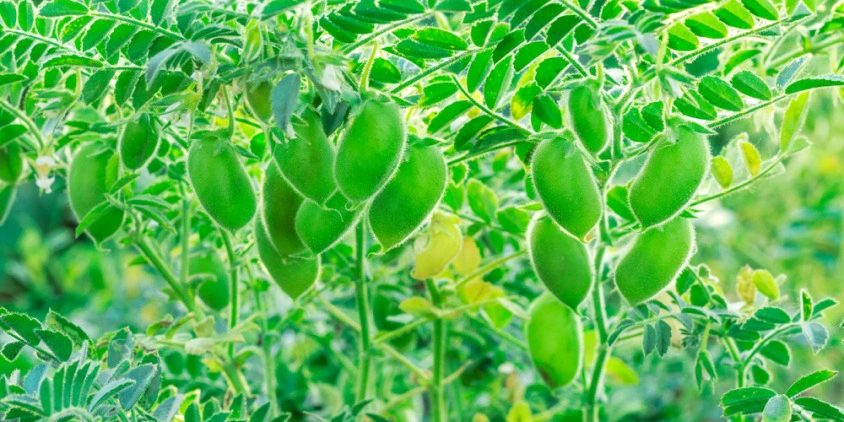
What Climate And Soil Do Chickpeas Grow In?
These legumes thrive in Mediterranean and semi-arid climates, preferring warm temperatures and full sun exposure throughout their growing season. The crop easily adapts to different soil types but produces the highest yields in medium-textured loams with good drainage.
Chickpea Climatic Requirements
These legumes are picky about temperature. They grow best between 70 and 80°F (21 and 27°C), struggling with both cold and heat, especially during flowering and podding crop growth stages. Temperatures below 59°F (15°C) kill pollen, while anything above 98°F (37°C) causes flowers to drop and prevents proper pod formation. Sunlight matters in chickpea crop cultivation just as much as temperature. Plants require six hours of direct sun every day, while less light means smaller plants and fewer seeds.
Farmers can choose the best field to grow the legume and organize field operations with the help of EOSDA Crop Monitoring, which gives accurate historical temperature, humidity, and sunlight along with up to 14-day weather forecasts for each field. Growers can now avoid crop damage by knowing exactly what’s occurring in their fields rather than assuming or responding to issues.
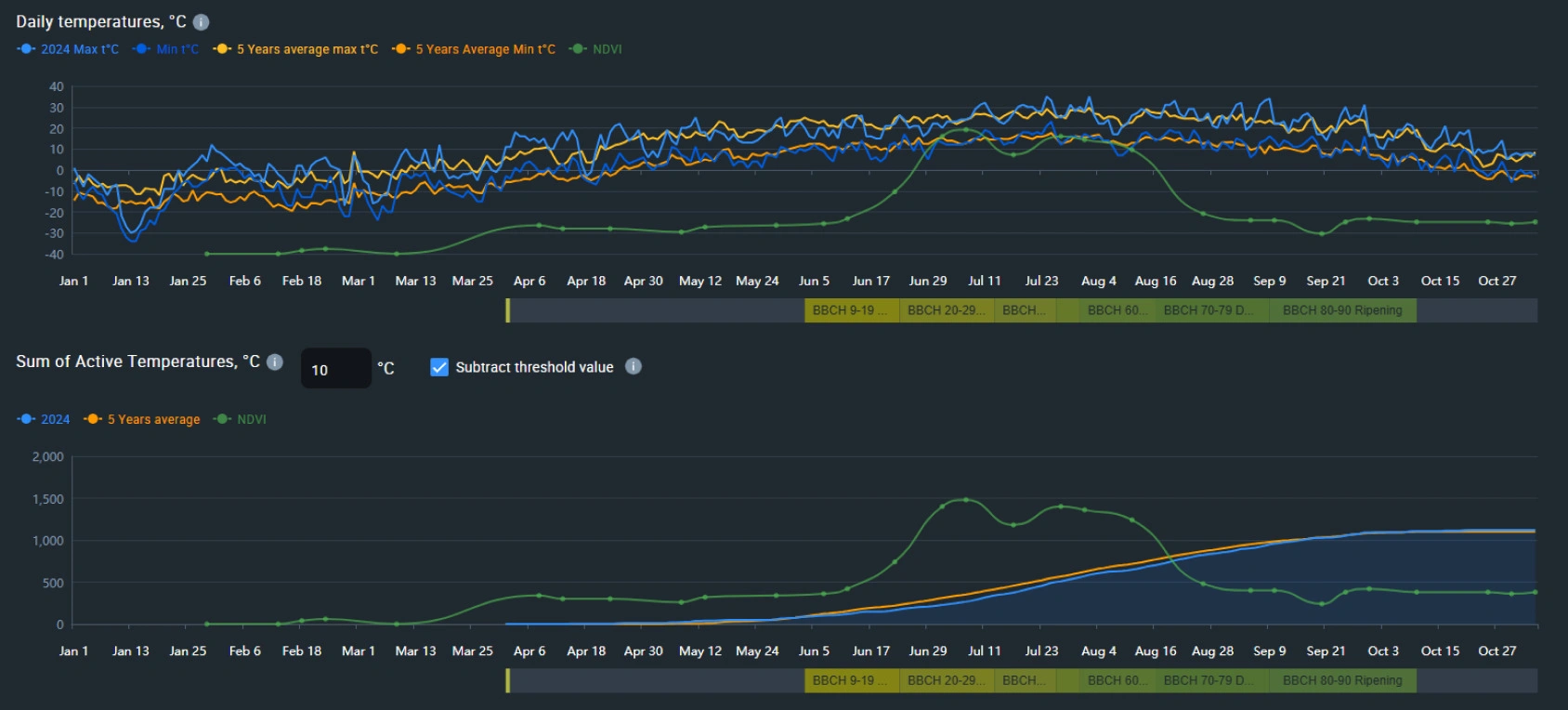
Chickpea Water Requirements
These legumes are quite drought-tolerant thanks to their long taproots that can draw water from deeper soil layers. When plants are in the pod-filling and flowering stages, they consume the most water, especially in the months of late June and early July. Achieving optimal moisture during these times is crucial for harvest success.
They need about 6–10 inches (152–254 mm) of water from precipitation and/or irrigation for the chickpea growing season. So, they are perfect for arid or poorly irrigated growing regions .
Chickpea Soil Requirements
For growing chickpea, look for sandy loam with a pH between 6.0 and 7.5 (neutral to slightly alkaline soil). Avoid growing in heavy clay fields where the water doesn’t drain well enough and the plants, sensitive to waterlogging, might suffer from root rot. Add compost or well-rotted manure to boost soil fertility, but only after you get the soil test results.
How And When To Plant Chickpeas In Different Climates
The techniques used for planting Desi and garbanzo beans have a direct impact on the crop establishment and final yields. Growing conditions and available resources determine the most suitable chickpea planting method:
- Direct field sowing. Seeds go directly into prepared soil at depths of 1–2 inches (2.5–5 cm) when soil temperatures are at least 45°F (7°C). Spring planting occurs 2–4 weeks before the anticipated last frost, while fall planting typically occurs in mid-summer. This method requires less labor, is more cost-effective, and reduces transplant shock because plants establish directly in their growing environment. However, it’s important to protect seeds from birds and rodents, as they may dig up or eat them.
- Transplanting. Here, farmers first plant their seeds indoors 4–6 weeks before the anticipated last frost, gradually acclimate the seedlings to outdoor growing conditions, and finally transplant established seedlings into the field at soil temperatures consistently warmer than 45°F (7°C). While this planting method is not that typical for chickpeas, it’s beneficial in harsh climates.
Space seeds 6–8 inches (15–20 cm) apart in rows that are 18-24 inches (46–61 cm) apart. This spacing improves air circulation and sunlight penetration, lowers disease risk, and allows for easier weeding and harvesting.
How To Care For The Growing Crop
Accurate water management, fertilization that supports the crop’s natural nitrogen-fixing abilities, and integrated pest control are the main tools for maintaining healthy croplands and protecting potential yields. Let’s consider in more detail how to put these approaches into action.
Chickpea Fertilizer Requirements
Soil testing allows you to determine the precise nitrogen (N), phosphorus (P), and potassium (K) fertilizer requirements for optimal chickpea growth in a given field. As a legume, the crop can fix 60-80% of its nitrogen requirements, so starter nitrogen fertilizer is often sufficient except in very N-poor soils.
The crop has a relatively high phosphorus requirement for healthy root development and nitrogen fixation. Growing chickpeas draw a lot of potassium from the soil; therefore, it’s important to replenish it. Potash fertilizer application boosts the crop’s resilience to stresses like drought, pests, and diseases.
Chickpea Pests And Diseases And Their Control
Despite chickpeas’ hardiness, uncontrolled pest infestations and disease outbreaks can destroy harvests within weeks. For example, even with the varieties rated as highly resistant to root rot, severe crop losses of up to 70% are possible in disease-friendly environments . Browse through this overview of the major threats to spot early warning signs and implement timely control measures for protecting your crops.
| Pest/Disease | Symptoms | Control measures |
|---|---|---|
| Aphids |
|
|
| Root rot |
|
|
| Thrips |
|
|
Proper crop rotation can be your first line of defense against pests and diseases. Crop rotation with cereals such as wheat or barley is particularly effective against soil-borne pathogens. Keeping chickpeas out of the same field for 3-4 years naturally breaks pathogens’ cycles before they can take hold. The Crop rotation feature in EOSDA Crop Monitoring makes this preventive strategy simple to implement: here you can visually design your rotation schedule for each field and track its implementation year after year.
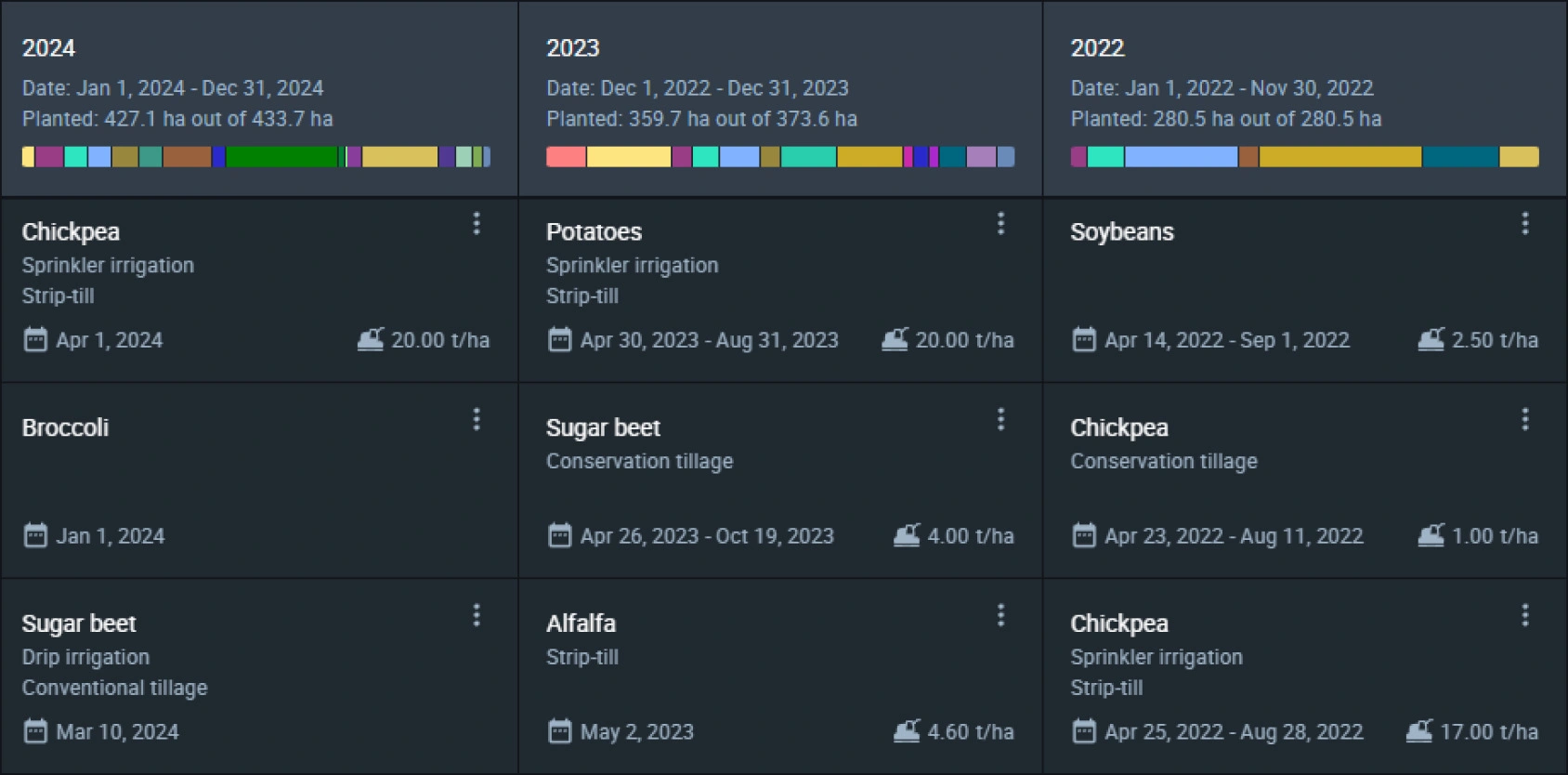
Chickpea Irrigation
These legumes demand steady moisture throughout the growing season, with flowering and podding stages being particularly sensitive to water stress. Commercial growers typically aim for consistent soil moisture without oversaturation, as waterlogged conditions can lead to root diseases and crop losses.
For optimal irrigation planning across large Desi and garbanzo beans’ growing areas:
- maintain one inch (25 mm) of water weekly in moderate climates;
- water more frequently in hot conditions until the top 2 inches (50 mm) of soil becomes moist;
- implement drip irrigation to minimize evaporation and target root zones;
- monitor soil moisture levels regularly to prevent water stress.
EOSDA Crop Monitoring’s NDMI-based maps and soil moisture analytics help growers optimize water application across extensive acreage. Our technologies help schedule precise watering based on current field conditions so that you can reduce water waste and ensure optimal moisture levels for the crop.
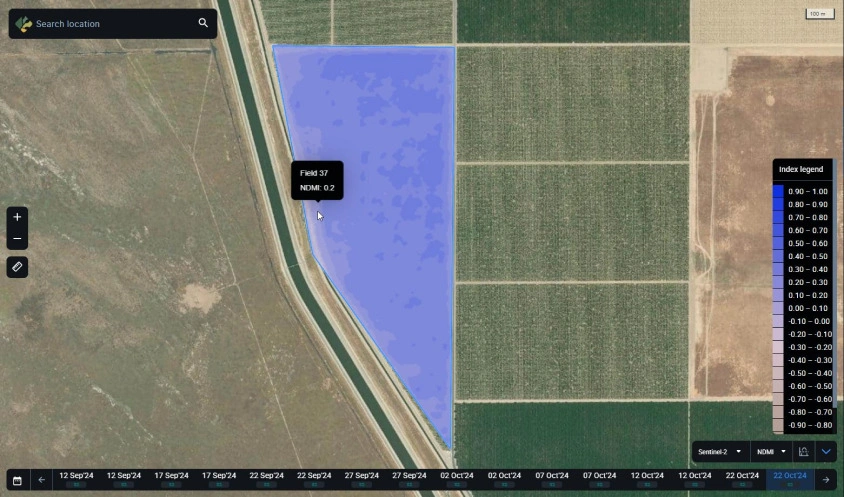
How Long Do Chickpeas Take To Grow?
The time it takes to grow chickpeas typically ranges from 90 to 120 days. Desi varieties grow faster (90–100 days), while Kabuli ones grow longer (110–120 days). Growth duration can differ because of certain growing conditions, including drought, excessive heat, or late-season rainfall. For example, late rains may trigger seemingly dormant plants to grow again, complicating harvesting. In such situations, chemical desiccation is frequently required to stop crop growth .
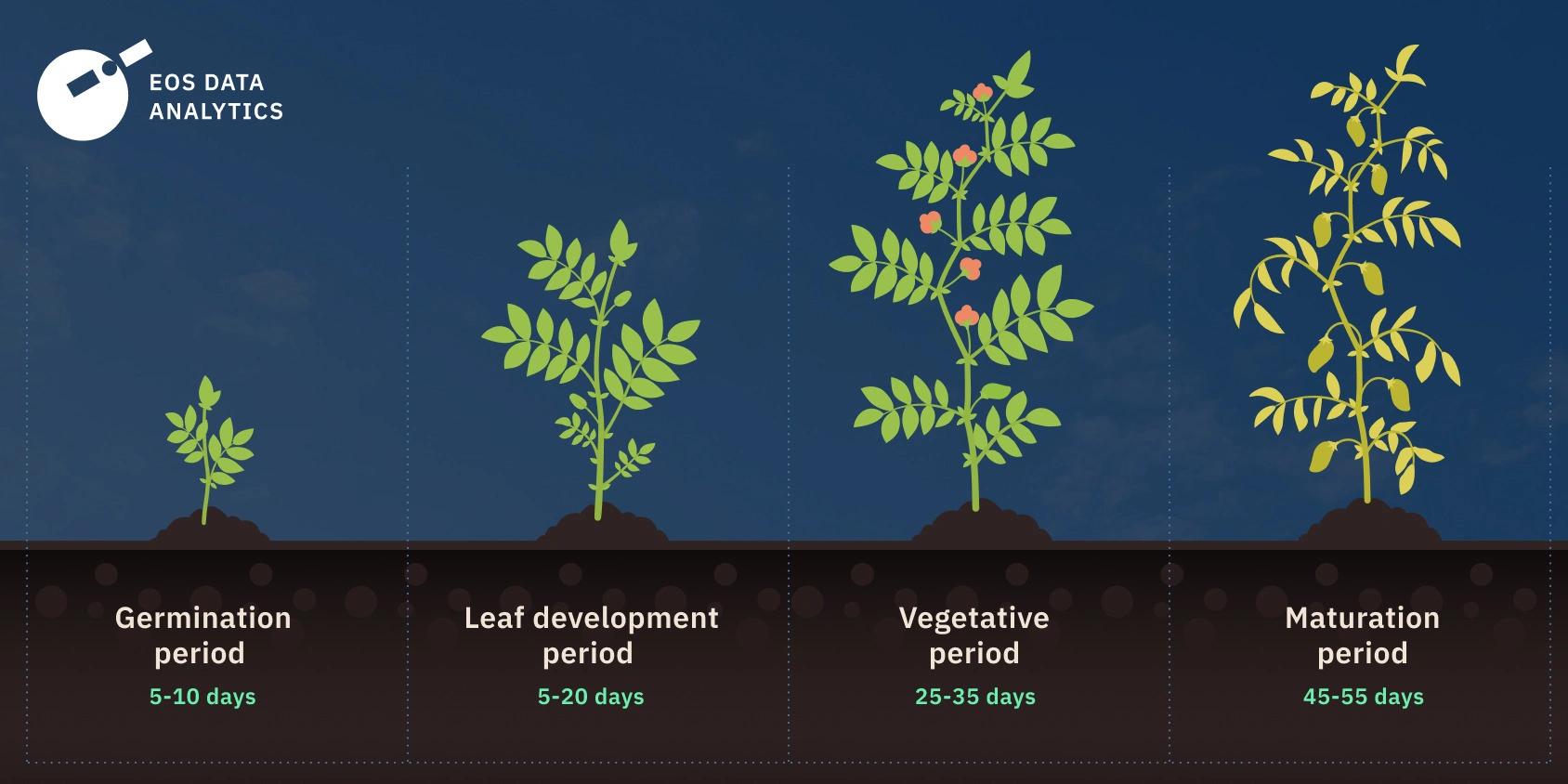
When And How To Harvest Chickpeas
The best time to harvest chickpeas is when the pods have turned brown and dried (around 13–14% grain moisture content) but haven’t yet split open. The crop is typically harvested in one of three ways:
- Mechanical harvesting. Commercial chickpea harvesting commonly employs combine harvesters. These machines require adjustments to settings like thresher speed and concave clearance to minimize cracking, especially for more delicate Kabuli varieties.
- Windrowing. It involves cutting plants and allowing them to dry in rows before harvesting. This method reduces shattering losses and enables earlier harvesting, which can be beneficial for managing weeds and improving seed quality. Our yield estimation technology can help commercial growers optimize their harvesting schedule across large fields to ensure consistent crop quality.
- Manual harvesting. In regions with limited mechanization, manual harvesting using sickles or other hand tools remains a common practice, especially for small-scale farming.
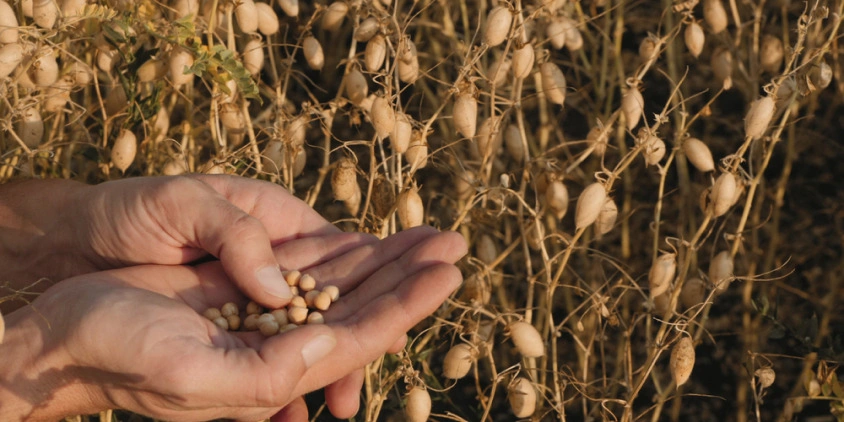
Once harvested, beans need proper storage conditions — ideally, temperatures of 32–50°F (0–10°C) in a low-humidity environment. Maintaining these conditions preserves beans’ market value and extends their shelf life. Careful attention to chickpea growing, harvesting, and storage techniques ensures that farmers can produce high-quality grain while successfully controlling soil health and production costs.
About the author:
Vasyl Cherlinka is a Doctor of Biosciences specializing in pedology (soil science), with 30 years of experience in the field. He attended the engineering college in Ukraine and received his degree in agrochemistry, agronomy and soil science in the Chernivtsi National University. Since 2018, Dr. Cherlinka has been advising EOSDA on problems in soil science, agronomy, and agrochemistry.
Recent articles

Analyze 2025 & Plan Your Best Year Yet: LandViewer Christmas Offer
It’s the most wonderful time of the year! The Christmas holidays are here, and so is your chance to analyze 2025 and plan a prosperous 2026 with more affordable Pro plans in LandViewer.

EOSDA Models Climate Change Impact On Sugarcane Yields
EOSDA modeled future temperature, rainfall, and other climate impacts on Veracruz sugarcane. The results help growers plan long-term adaptation strategies, including timing, varieties, and irrigation.

EOSDA LandViewer Black Friday Sale: Exclusive Offers & Giveaway
This Black Friday, LandViewer offers new users the chance to save on monthly plans, get extra months with yearly subscriptions, and participate in a free annual plan giveaway.